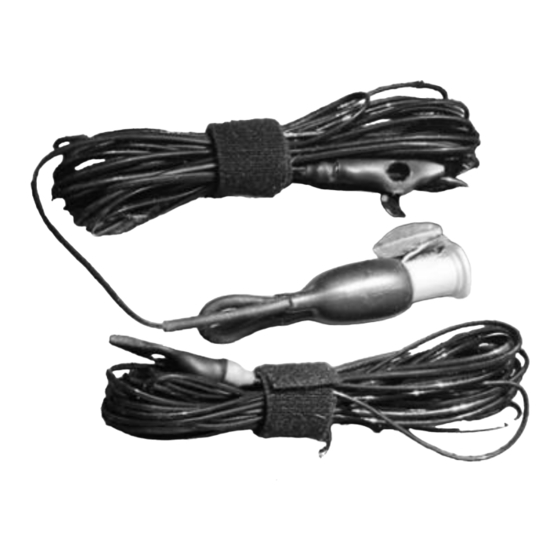
Subscribe to Our Youtube Channel
Summary of Contents for Chameleon Antenna HF Series
- Page 1 Single and Multi-Band Pocket HF Antenna Series (CHA Pocket Series) Operator’s Manual Nevada - USA WWW.CHAMELEONANTENNA.COM VERSATILE – DEPENDABLE – STEALTH – BUILT TO LAST...
-
Page 2: Table Of Contents
20 Meter Dipole..........................10 Dipole and OCFD Antenna Installation ....................12 Recovery Procedure .......................... 13 Troubleshooting ..........................13 Chameleon Antenna Products ....................... 14 References ............................14 Be aware of overhead power lines when you are deploying the CHA Pocket Series. You could be electrocuted if the antenna gets near or contacts overhead power lines. -
Page 3: Introduction
Introduction Thank you for purchasing and using one of the new Chameleon Antenna Single and Multi-Band Pocket High Frequency (HF) Series antennas (CHA Pocket Series). The CHA Pocket Series are a series of single and multi-band HF antennas that can literally fit in your pocket when not in use. There are three models available: a 40-6 Meter Off-Center Fed Dipole (OCFD), 40 Meter Dipole, and a 20 Meter Dipole. -
Page 4: Hf Propagation
The CHA Pocket Series can be deployed by the operator in the field in approximately 20 minutes, using a tree or light-weight telescopic pole. Antennas built by Chameleon Antenna are versatile, dependable, stealthy, and built to last. Please read this operator’s manual so that you may maximize the utility you obtain from your CHA Pocket Series antenna. -
Page 5: Antenna Series Descriptions
successful communications between two points is predicted on 50% of the days of in a month. The LUF is the frequency below which successful communications are lost due to ionospheric loses. The OWF, which is somewhere between the LUF and around 80% of the MUF, is the range of frequencies which can be used for reliable communication. -
Page 6: Meter Off-Center Fed Dipole
40 Meter Off-Center Fed Dipole 40 through 20 meters are the most useful bands for portable QRP operation. These bands will enable the portable operator to have both daytime and nighttime capability for short (using NVIS), medium, and long-range communication. Also, the antenna itself is a manageable size for portable operations – even more so with the CHA Pocket OCFD! Figure (3) shows a self-supporting Inverted V field installation using a 13-foot lightweight fiberglass telescoping “Crappie”... - Page 7 Figure 4. 40 Meter OCFD SWR by Frequency. CHA Pocket Series Page 7...
-
Page 8: Meter Dipole
40 Meter Dipole 40 meters is arguably the most popular band for portable QRP operation. It will enable the portable operator to have dependable short (using NVIS) to medium range communication during the day and medium and long-range communication at night. Also, the antenna itself is a manageable size for portable operations –... - Page 9 Figure 6. 40 Meter Dipole SWR by Frequency. CHA Pocket Series Page 9...
-
Page 10: Meter Dipole
20 Meter Dipole The CHA Pocket 20 Meter Dipole is probably the easiest, lightest, and smallest antenna you can take into the field. It requires only one support, such as a small tree or a lightweight fiberglass telescoping “Crappie” pole. The antenna can be configured as a Flat-Top or Inverted V. Figure (9) shows a self- supporting Inverted V Beam;... - Page 11 Figure 10. 20 Meter Dipole SWR by Frequency. CHA Pocket Series Page 11...
-
Page 12: Dipole And Ocfd Antenna Installation
Dipole and OCFD Antenna Installation The CHA Pocket Series Dipole and OCFD Antennas are comprised of the components shown in plate (2). The letter references are used to identify components in the installation procedure. The antennas can be installed as a Flat-Top (Horizontal Dipole) or Inverted V. Use the procedure below to install the Dipole and OCFD antennas. -
Page 13: Recovery Procedure
5. Check your frequency to ensure you are operating within the specified frequency range of the antenna. 6. If still not operational, contact Chameleon Antenna for technical support. Be sure to provide the specific indications of the problem (e.g., “My antenna tuner can’t find a match when tuning up and I don’t hear anything while receiving.”. -
Page 14: Chameleon Antenna Tm Products
Chameleon Antenna Products Please go to http://chameleonantenna.com for information about additional quality antenna products available for purchase from Chameleon Antenna – The Portable Antenna Pioneer References 1. Silver, H. Ward (editor), 2013, 2014 ARRL Handbook for Radio Communications, 91 Edition, American Radio Relay League, Newington, CT.













Need help?
Do you have a question about the HF Series and is the answer not in the manual?
Questions and answers